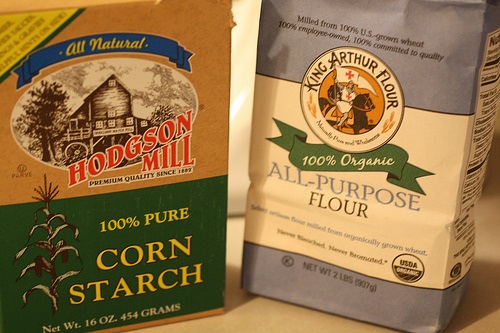Difference Between Flour and Cornstarch

Flour vs. Cornstarch
In the cooking and baking world, flour and cornstarch are two of the most vital ingredients in cookery. Both flour and cornstarch are starches, and both are used similarly as thickening agents in many types of sauces in various cuisines.
Cornstarch, as it name implies, is a starch made from corn. The starch is a fine, white powder flour that comes from the white heart of the corn, also known as endosperm. Another name for cornstarch is corn flour. On the other hand, flour is made from wheat, and it is the traditional thickening agent.
Cornstarch is a pure starch compared to flour. The reason for this is because flour contains gluten. The lack of gluten in cornstarch makes it more efficient in thickening. In fact, cornstarch has twice the thickening power of starch. The presence of gluten in flour makes it less effective.
Since the cornstarch has twice the thickening power compared to flour, the amount of cornstarch used is usually half of that of flour in a given recipe. Another advantage of cornstarch over flour is that cornstarch doesn’t usually create lumps, while lumps are evident when using flour. The cornstarch mixture also doesn’t require any flavor to be added to the base, and it doesn’t mask any flavor or taste. As a mixture, the cornstarch mix blends more easily compared to the flour combination. The mix also doesn’t absorb liquid until it cooks.
Cornstarch as a thickening agent produces a clear and light shine or gloss to the sauce, while the flour mixture will add a white, opaque, and cloudy appearance. The cornstarch mixture is used for dairy-based sauces like custards and gravies, while the flour mixture is used in white or cream soups. The flour mixture can also be used as a roux wherein the flour and fat are combined.
Another notable difference between the cornstarch mixture and the flour mixture is the temperature of the water. Cornstarch is mixed with cold water because the starch will get lumpy if hot water is added. In contrast, flour is blended with hot water. Both mixtures can be added to the sauce base or soup after combining the dry and wet ingredients. It is also important to note that the cornstarch mixture doesn’t mix well with any kind of acid in liquid form.
Both cornstarch and flour mixtures can be subject to thinning. When this happens, a couple of factors come into play. The mixture might have unequal amounts of liquid and the dry ingredient (whether it is cornstarch or flour). Usually, the amount of the liquid is smaller compared to that of dry starch. This can be remedied be adding more hot or cold water, depending on the type of thickening agent. Another factor might be an excess of other ingredients like sugar, fat, and acid. Excessive stirring and freezing the mixture can also contribute to its thinning.
Another issue is the formation of lumps. One solution to remedy this situation is to put the mixture in a blender and have the machine blend the ingredients evenly. Straining can also be another reliable method.
Summary:
1.Both cornstarch and flour are thickening agents used for sauces and soups.
2.The cornstarch mixture has an advantage of having twice the thickening power compared to flour. The presence of gluten in flour makes it less effective.
3.Cornstarch is added to cold water, while the flour is mixed with hot water.
4.The cornstarch mixture produces a shine or gloss, while the flour blend leaves an opaque and cloudy look.
5.Cornstarch is made from corn, while flour is made from wheat.
- Differences Between Fraternity And Sorority - January 8, 2014
- Differences Between Lucite and Plastic - January 7, 2014
- Differences Between Oil and Butter - January 6, 2014
Search DifferenceBetween.net :
7 Comments
Leave a Response
References :
[0]http://mymadisonbistro.com/how-to-make-cake-flour/

Very helpful. Thanks a bunch
Very helpful, thank you. I had no idea the big difference.
Thank you very much! I learned a lot. The summary part also helps to wrap things up. Thank you!!!
Very helpful.
It clears up a lot of misconceptions.
Thank you?
Love it
Very interesting. Was not aware of the differences. Thank you
So interesting! Great information. Thank you.